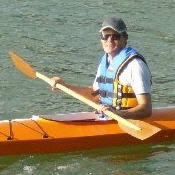I must admit that I like the idea of not only building my own boat, but also designing its lines. And through reading Gavin's blog, I've developed a respect and increasing interest in older boats and ships.
While I was paddling round the upper Waitemata Harbour at the weekend, I was fascinated by the many boats I saw moored up along the way. One of these I suspected to be a converted sailing scow, a commercial vessel from 100 years ago, essential in the development of Auckland as a city.
Today I went with my parents to the National Maritime Museum. We took a look at the racing boats and sponsor's yachts and launches, here in town for the Louis Vuitton Pacific Series and then headed for the museum. They wanted to potter around and enjoy the waterfront, but I was on a mission.
I took lots of notes and photographs of the exhibits in the Hawaiki hall, especially of this Kiribati canoe. It is a proa, that is it does not tack but shunts, the outrigger stays to windward and the lower point of the sail is moved to the other end of the boat and it 'reverses'. This is in fact a western prejudiced way to think of it, for in this type of boat the axis of symmetry is shifted 90 degrees and there is no front or back, but a windward and leeward. Anyway, I want to build one so I thought I'd examine an original rather than use plans of a western interpretation.

I also wanted to check out the Ted Ashby, one of the few remaining sailing scows still working for a living, albeit as a harbour cruise distraction for the paying visitors to the museum.

Between the Pacific craft in the Hawaiki hall and the quay where the Ted Ashby and other vessels are moored, I came across this beautiful rowing boat. It spent its working life in the Auckland Islands, 300 km south of the main New Zealand land masses. It appears to never have been used though. It was stationed on the islands along with cashes of food and clothes in case of ship wrecks.

I intend to deliver more on each of these vessels. I'll digest my notes and try and define the critical forms, structures and mechanisms of the sailing canoe, determine whether the boat I sighted was indeed an original scow (with the help of a volunteer and model maker at the museum) and publish more photographs and details of the boat and the castaway station on the Auckland Islands.

No comments:
Post a Comment